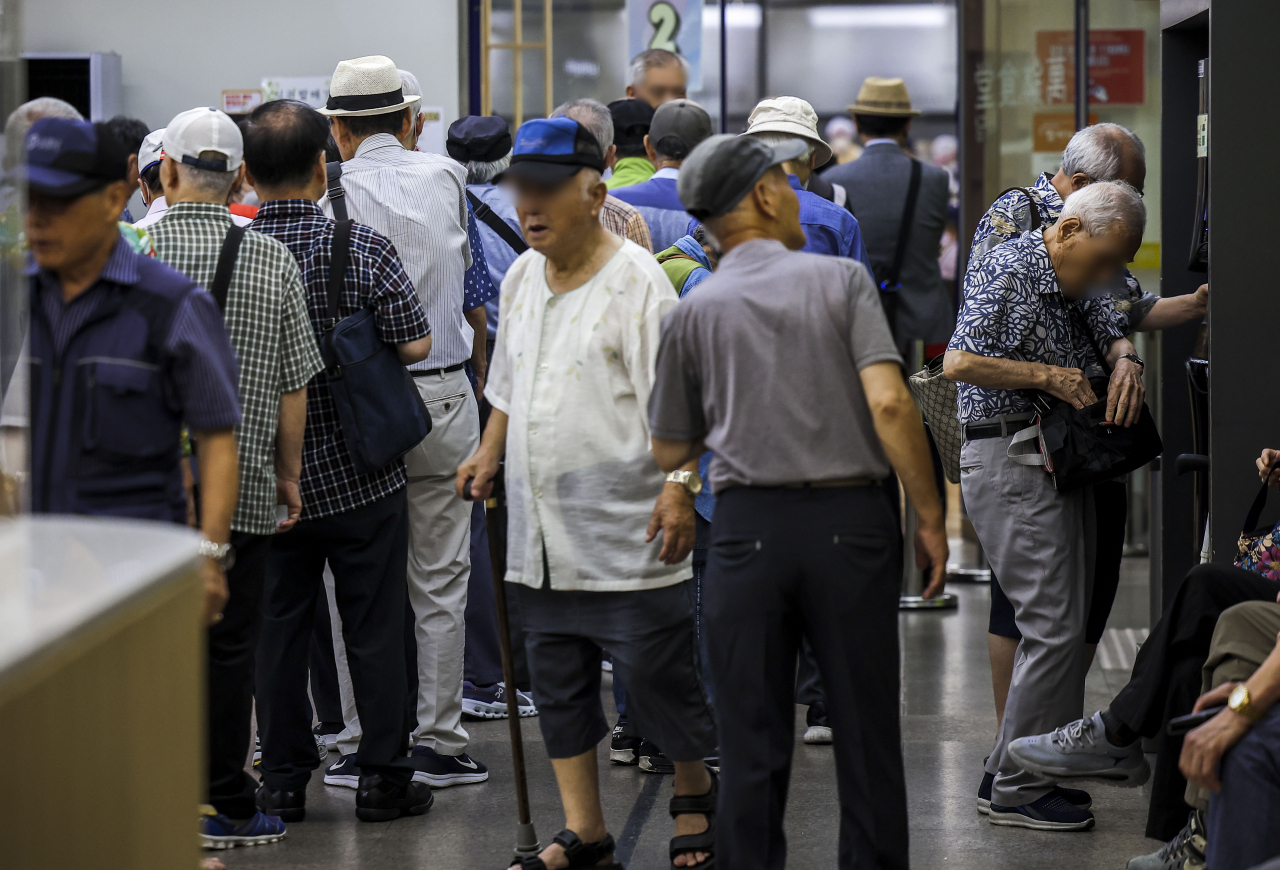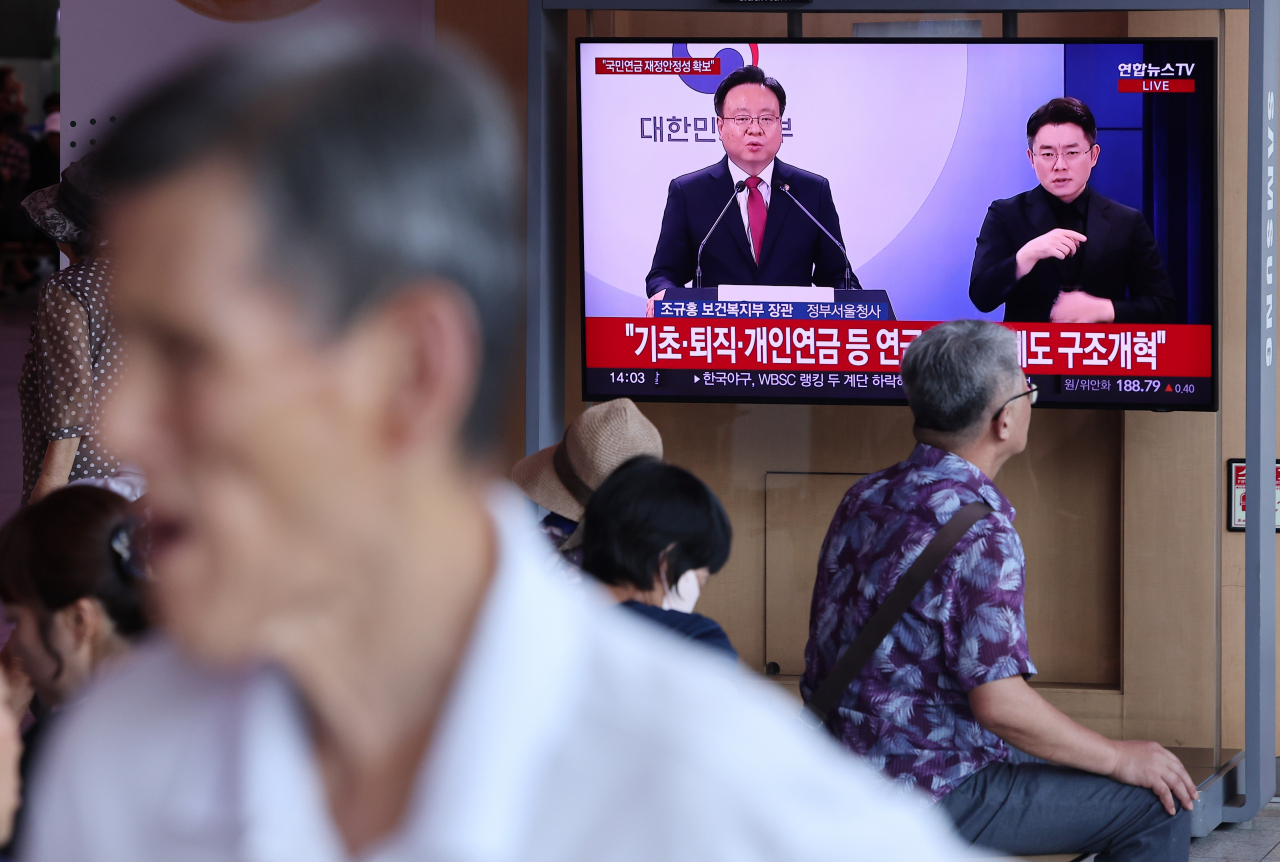 |
Senior citizens queue up for lunch at a senior welfare center in Jongno-gu, Seoul on Aug. 26. (Newsis) |
The South Korean government on Wednesday laid out plans to raise the mandatory national pension contribution rate by 4 percentage points from the current 9 to 13 percent starting next year, with the intention of extending the life span of the state-sponsored public retirement pension scheme by at least 16 years.
This reform plan comes as the national postretirement fund's financial viability remains doubtful, with the country suffering from the double whammy of low birth rates and an aging population.
If implemented as planned in 2025, the hike in pension contributions would mark the first one in 27 years since 1998. The reform proposal requires the parliament's approval.
Most of the reform agenda will revolve around the sustainability of the National Pension Service's mandatory postretirement scheme for all South Korean income-earners. Its fund was valued at 1,147 trillion won ($855 billion) as of end-June. The fund is estimated to be exhausted by 2056.
The government projected that the hike in pension contributions proposed for the first time in 26 years could slow down the mandatory pension fund's depletion by decades, if coupled with the introduction of an automatic balancing mechanism to the National Pension Service's retirement scheme -- already deployed in 24 of 38 member nations of the Organization for Economic Cooperation and Development.
"The pension reform has become the mission that needs to be fulfilled promptly for the country and the future of our children," Cho Kyoo-hong, minister of health and welfare, told reporters in a briefing at the Government Complex Seoul.
Under Wednesday's reform plan, a subscriber's contribution rate -- the share of their income that has to be paid each month -- would rise by 4 percentage points. The amount paid out to pensioners as a proportion of average pay would also slightly increase, from 40 percent as of 2028 to 42 percent -- less than the 50 percent level being considered in April that was also to come alongside a 4 percentage-point hike in contributions.
The pace of the increase in the level of contributions would differ by generation, according to the Welfare Ministry. A person who turns 50 in 2025, for example, would see contributions rise 4 percentage points by 2029, whereas it would take 16 years for a 20-year-old to see the same increase.
That adjustment would delay the fund's depletion by 16 years, according to the government.
Another change would be a proposed automatic balancing mechanism, which would adjust the level of pension spending without human intervention, depending on inflation, the number of new contributors in the last three years and the rate at which life expectancy is increasing.
The government suggested that, with the adoption of the automatic balancing system when the fund's pension spending outgrows its income from contributions -- namely in 2036 -- the fund would not deplete until 2088. The scheme, aimed at revising down pensioners' incomes in the event of a decrease in pension contributors and the aging of society, may be put in place later in 2054, if the fund suffers a deficit. The government did not confirm the timeframe for deploying this mechanism.
Separately, the government will urge the NPS to boost overseas alternative investments and empower its foreign branches to increase the rate of return on investments by at least 1 percentage point.
The government will propose revising legislation starting 2025 and secure the state budget beginning in 2026.
 |
A pedestrian walk past a TV screen broadcasting Welfare Minister Cho Kyoo-hong's press briefing in Seoul on Wednesday. (Yonhap) |
These plans are the administration's follow-up to President Yoon Suk Yeol national pension structural reform proposal last week, after he hinted at moving forward despite protests and intense political conflict between the rival parties.
Overcoming the parliamentary hurdle appears to be a tall order for the government, given that the main opposition party holds the majority in the National Assembly. Rep. Park Chan-dae, floor leader of the main opposition Democratic Party of Korea, described Yoon's proposal as one "renders the National Assembly's previous discussions useless and divides the people."
According to the official calculation in 2023, South Korea's pension fund will see its pension expenditures grow larger than the fund's total incoming revenue by 2041, and the fund will run out by 2056 at the current rate of contributions of 9 percent of each full-time employee's income for up to 40 years, with payments of roughly 40 percent of each employee's preretirement annual income.
As of 2023, 22.38 million South Koreans -- nearly half of the total population -- were contributing to the plan, while 6.82 million people aged 65 or older were beneficiaries.
The latest estimate implies that on average Korea's workers paid contributions for 17.3 years, and drew out 620,000 won per month until they died. Those who have paid contributions for at least 10 years are eligible for the pension payout.
The NPS' public retirement pension fund is part of the two-tiered state-sponsored retirement plan, along with what is called the "basic pension" scheme for low-income seniors.
Under Wednesday's reform plan, Seoul will raise the basic pension payout for all eligible senior citizens -- aged 65 or older who belong to the bottom 70 percent of the income bracket at their age -- to 400,000 won per month. Also, the government is seeking to render basic pension recipients ineligible if they have resided in South Korea for less than 5 years at age 19 or older.
Some 6.51 million basic pension recipients as of the end of 2023 were paid up to 334,810 won per month. This cost the country 244 trillion won as of 2024, up 3.5-fold from a decade earlier, as the number of recipients increased 50 percent in 10 years.
Nearly half of basic pension recipients were also recipients of the NPS' postretirement pension scheme.







![[Today’s K-pop] Blackpink’s Jennie, Lisa invited to Coachella as solo acts](http://res.heraldm.com/phpwas/restmb_idxmake.php?idx=644&simg=/content/image/2024/11/21/20241121050099_0.jpg)